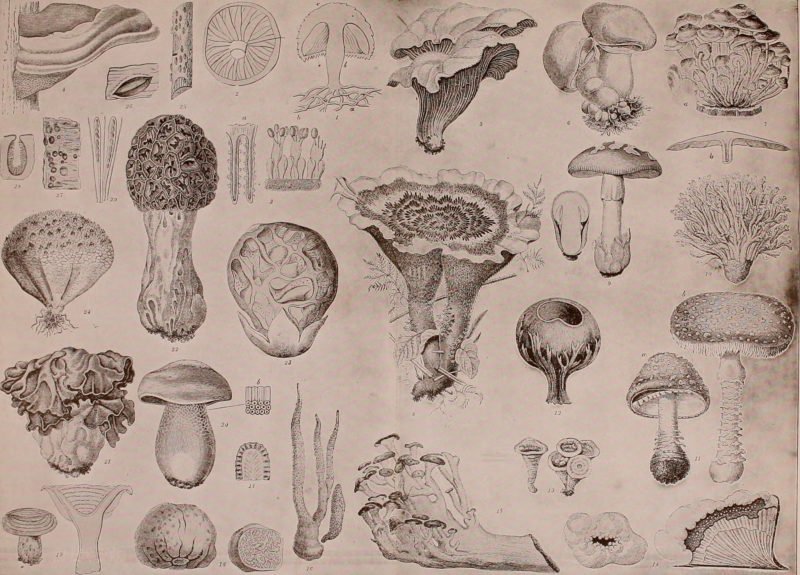I’m walking through an aspen grove next to a steep ridge, looking up at the mossy bases of big ash trees. They have a shaggy, mottled look—evidence of the emerald ash borer beetles that have ravaged them over the past decade.
Morel mushrooms grow near these trees, and they seem sparser with each year that passes, as dead ashes crisscross the forest floors. The white morels (which tend to look more gray or even yellow, depending on where you find them) are often thought to appear toward the end of the season; first, the elusive black morels appear. The locals usually say it’s cyclical, or that the mushrooms will adjust and find another sort of tree to live with. But everyone’s noticed a dearth of black morels this year.
When I was young, I remember valleys carpeted with black morels. They were often petite, but always intricately sculptural and beautiful, gnomic and nestled between Jack in the Pulpit and trillium flowers. This year I found only five in a gravely patch that I recalled only moments before stumbling upon it, deep in the woods. Finding morels often works like this for me: I head out of the house with a vague sense of direction, but usually I don’t clue in to the exact spot I’m headed to until just before I’m on top of it. Then there is a flash of deep recollection or attunement, and I look down and there they are.
It’s early June as I write this; the season is effectively over. There are still a few morels to be found, but by this point they will most likely be slug-nibbled and sun burned, way past their prime. While I heard a few rumors about big hauls of morels discovered in swampy areas, most people I talked to were left flummoxed by this year’s crop. People often tell stories about how these mushrooms are mysterious. Morels will hide and then show up almost whimsically in abundance, right before your eyes. Case in point: a couple of weeks ago I went on a two-hour walk looking for morels, ranging over some fairly remote areas of the national lakeshore that should have been bursting with mushrooms. But I didn’t find a single one. The following morning, I walked out of my front door to see a plump, fresh white morel popping out from between two rocks a foot away from the house, as if winking at me. As Anna Lowenhaupt Tsing writes in The Mushroom at the End of the World, “When gathering mushrooms, one is not enough; finding the first encourages me to find more.” Even after a fruitless hunt the day before, I am suddenly motivated to try again.
It’s especially fun to teach kids to hunt for morels. Children are literally closer to the ground, and once they learn to spot morels they can be astonishingly adept at picking them out of the dizzying patterns of leaves and ground cover.
This year’s black morel scarcity invariably comes up when I’m talking to locals about how many they’ve found so far. (But never where. Morel hunters are notoriously cagey about their secret spots). One thing that hasn’t is the C word—or, rather, the CC words: climate change. No one has ventured that climate change might have something to do with the disappearance of the black morels. And, to be clear, I’m not at all sure that myself. Still, it is surprising that I haven’t heard the phrase uttered by the people I’ve talked to, who are saddened by the low turnout in what, by most accounts, was supposed to be a good spring for morels (cool, plenty of ground moisture, etc.).
Then again, “climate change” carries so much rhetorical baggage—particularly right now. To cite climate change as the probable cause of any ecological shift or perceived imbalance is to come out strongly, if indirectly, against the current administration and its ilk. They are fighting words, politically speaking. Furthermore, to evoke “climate change” with sincerity is to admit some kind of vulnerability, and to cast some blame at humans—at ourselves. The way climate change is understood and wielded is so often accompanied by self-criticism, and self-criticism is hardly practiced by leaders and followers who recite mantras of pride, nationalism, and winning at any cost. Climate change is for losers.
But then, we’re definitely losing a lot of trees back in the woods. Even if there’s not a direct causal relation here, there are certain realities that are uncomfortable to acknowledge, but impossible to ignore: irregular weather patterns, freak storms, and non-native species at every turn. Climate change has become a euphemism for a whole host of difficulties involving ecological dynamism and evolutionary impermanence. It’s about admitting that we will never be “winners”—and also, that life is not a war, and not a game. To take climate change seriously is to signal a willingness to roll up one’s sleeves and commit to various real-world problems and actions: reducing waste, minimizing one’s footprint, caring for other species, and so on. So much simpler to keep our heads down, our mouths shut, looking for these ineffable, tasty mushrooms.
One of the deep ironies of morels is that they also thrive in disturbed landscapes. A mountainside ravaged by wildfire, black stumps spread out like some motley cemetery? Perfect for morels the following spring. A hillside logged left stripped and ragged? Morels will move right in. A gravel road right by unapologetic tire tracks? There they are! So even if climate change were to have something to do with the vanishing black morels, who’s to say that they wouldn’t spring up just after the closure of the Anthropocene? Morels may remind us about our temporary spell on this planet, and they may also teach us to seriously ponder the messier aspects of coexistence.

